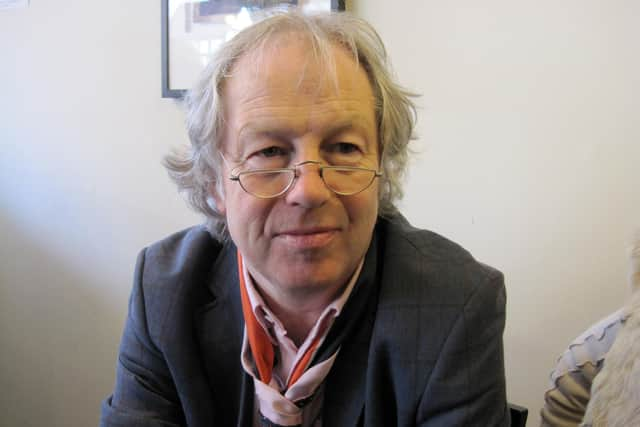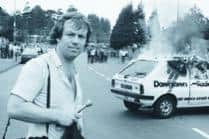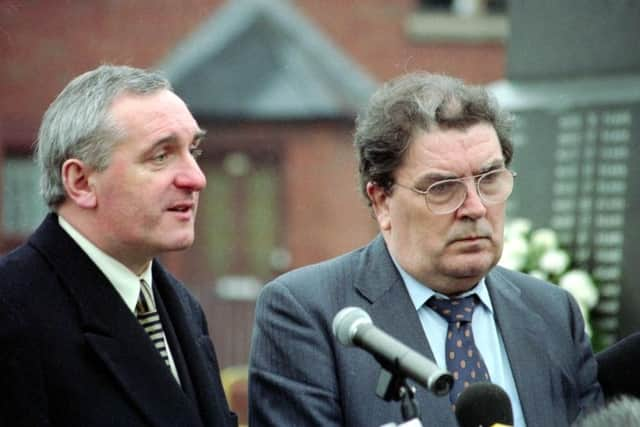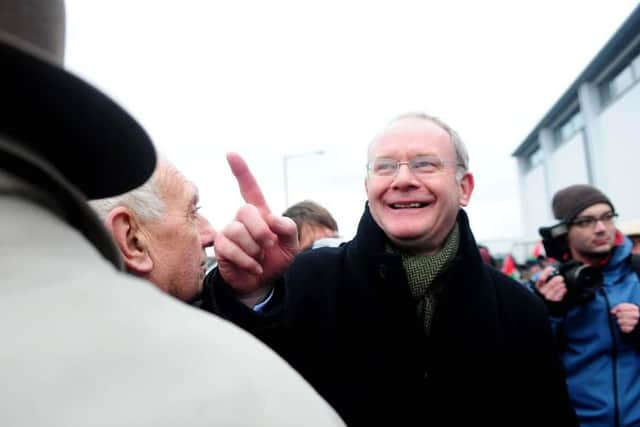Eamonn Mallie’s new memoir sheds fresh light on war and peace with Hume and McGuinness to the fore
and live on Freeview channel 276
It was August 18, 1994 and the award-winning journalist drove to Derry to ask Mr. McGuinness if all the speculation about an imminent cessation was true.
“I always had a good rapport with him. I went to his house and had a very frank discussion. ‘I have to be brutally frank with you Martin, I cannot and could never live with political violence or violence for political reasons. That's my position’...
Advertisement
Hide AdAdvertisement
Hide Ad"He stared at me with those steely blue eyes and said, 'How do you think I feel?' It was one hell of a moment. It almost seemed to me he was waiting to say it.”


Before leaving he asked him about the timing of a ceasefire.
“‘Martin, would it be wise for me to be out of town when all the speculation is taking place?’ Again he gave me those eyes: 'Eamon, I wouldn't be out of town.'”
Mr. Mallie left Westland Terrace and drove from the Bogside back to Belfast where the senior political correspondent had a chance encounter with a near neighbour of Mr. McGuinness’ in a hotel.


Advertisement
Hide AdAdvertisement
Hide Ad“I don't know what possessed me but I walked into the Wellington Park Hotel which is not too far from my home that night and Hume was sitting alone in the reception crestfallen, head down.
"I walked over and said, 'Hello John'. He lifted his head and said, 'What do you think Eamonn?' Now here was God. Here was the guru. I knew what he was saying, 'Do you think the IRA will ceasefire?' and he was asking me.
“He would have been my torch. He would have been my family's torch historically. We would have looked to Hume for leadership and hope for all of us coming from border areas and here he was saying to me, ‘Eamon, what do you think?’
“So I had to put on my professional cap. I had in my head extraordinary information. McGuinness had more or less confirmed that in the next few weeks there would be a ceasefire but I had to put on my professional cap and so I said, ‘We have a saying in our part of the country John – keep the faith. He said, 'Do you think so?' and I said, keep the faith. I walked away and on August 31 the miracle happened.”


Advertisement
Hide AdAdvertisement
Hide AdThese vignettes are among a rich seam of insights and anecdotes contained in the South Armagh-native’s new memoir ‘Eamonn Mallie: Eyewitness to War and Peace’.
The book abounds with fresh and illuminating details that will hold plenty of interest for a Derry audience.
Speaking to the ‘Journal’ Mr. Mallie acknowledges that John Hume – one of his key protagonists – was a political visionary able to imagine the peace process decades before it played out.


"Hume was a giant. I would say that John Hume was the most creative, imaginative political leader in these islands in a century. I would only compare him to Victor D'Hondt, the Belgian jurist and political scientist.
Advertisement
Hide AdAdvertisement
Hide Ad“Hume was our D'Hondt. He had the imagination, the creativity to find, not just a formula but words to articulate that formula, that resolution of the problem,” he said.
To illustrate the point he recalls the ‘great intellectual’ and civil servant Maurice Hayes telling him how Mr. Hume had sketched out the structures of what would become the Good Friday Agreement as early as the mid 1970s in the aftermath of the Ulster Workers’ Strike and disappointment over the collapse of the Sunningdale power-sharing experiment.
“In 1975 Hume was speaking to an SDLP delegation in Strangford and [Hayes] invited him to stay with him overnight in his home. Over the course of the evening Hume took out a cigarette packet and wrote the structures, which eventually became the structures of the GFA: three sets of relationships, the principle of the right of the Irish people to self-determination, and the consent principle, and key among all of this, the necessity for referendums on both sides of the border,” says Mr. Mallie.
By the mid to late 1980s Mr. Mallie was on hand to report upon the genesis of what would become the Hume-Adams talks.
Advertisement
Hide AdAdvertisement
Hide AdHe remembers Taoiseach Charles Haughey and Mr. Hume being convinced the only way of realising peace was by bringing Sinn Féin ‘in from the cold’.
But direct engagement between the republican movement and the Irish Government was politically impossible due to a hangover from Mr. Haughey’s embroilment in the Arms Crisis in 1970 when he had been accused of conspiring to provide arms to the IRA.
To get around this Haughey asked Fr. Alec Reid to ‘persuade John Hume to talk to Gerry Adams’ and that if he succeeded ‘then Hume will be my proxy’.
"Fr. Reid was desperate to stop the killing. He went away to draft a letter as suggested by Haughey.
Advertisement
Hide AdAdvertisement
Hide Ad“I was told by an acquaintance of mine at the Department of Foreign Affairs (DFA) who is now retired that when Fr. Reid left Haughey's house he went to Great Sugar Loaf and climbed the mountain to get closer to the Holy Spirt for inspiration in writing his letter. I checked with Mark Durkan and Mark Durkan told me he remembers the day that Hume showed him the letter that Fr. Reid wrote to him.”
Another crucial moment occurred on a beach in France where Mr. Hume had invited Seán Donlon, a senior diplomat at the DFA in 1991.
The SDLP leader used a colourful analogy to explain to Mr. Donlon why the policy of isolating Sinn Féin needed to change.
“He spoke of a cactus and caucus structure and said to Donlon that all the pricks were on the outside of the cactus. The challenge was to transmute or convert the cactus into a caucus where everybody is included and that means Sinn Féin. That was at the heart of what he was about...those were the foundations of the GFA.
Advertisement
Hide AdAdvertisement
Hide Ad"Donlon said, ‘London won't buy it, Dublin won't buy it and Washington won't buy it. And who was right? Hume was right. He was a political giant.”
Mr. Hume had been an invaluable source to Mr. Mallie as a political journalist covering developments. He used to drive up to Greencastle where the Foyle MP would allow him to peruse the latest literature emerging from the talks and political process.
“Hume was unbelievable. He was very good to me. He used to ring me up to come up to Donegal to see him. He would have all the papers there spread out in a room.
"I wouldn't be allowed to take them away but I'd be allowed to read them and take notes. He would say to give him a shout when I had read them.”
Advertisement
Hide AdAdvertisement
Hide AdMr. Mallie reserves special mention for Mark Durkan who was Mr. Hume’s ‘chef de cabinet’ for much of the period covered. He says that of ‘all the politicos of that era’ he was a ‘rare organiser and thinker’.
"He was the most intellectually sound of all the people in politicos that I have met,” he said.
‘Eamonn Mallie: Eyewitness to War and Peace’ is available from all good bookshops and directly from the publisher at www.merrionpress.ie.